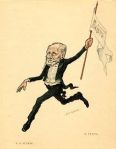Ballet fantastique in one act
Music by Ludwig Minkus
Libretto by Marius Petipa
Décor by Mikhail Bocharov and Karl Valts
Costumes by Adolf Charlemagne, Pavel Grigorev and Nikolai Klodt
World Première
30th May [O.S. 18th May] 1883
Imperial Bolshoi Theatre, Moscow
Original 1883 Cast
The Queen of the Night
Eugenia Sokolova
The Queen of the Day
Ekaterina Vazem
The Night Star
Maria Gorshenkova
The Morning Star
Anna Johansson
The Fly
Pavel Gerdt
The Dove
Varvara Nikitina
The Queen Bee
Alexandra Vinogradova
A Swan
Augusta Ogoleyt
A Naiad
Alexandra Shaposhnikova
Plot
The whole of nature has gone to sleep. The Evening Star appears in the company of other stars and planets. Dryads, naiads and nereids appear. They all circle in a dance at the feast of Night. With the first rays of the rising sun, the triumph of Day begins. Nature comes to life. All the ethnic groups living in Russia join together to welcome the sun. The common delight expresses itself in a great round dance. The Spirit of Russia reigns over all on the wings of an eagle, surrounded by embodiment of the arts, sciences and industry.

History
Night and Day (La Nuit et le Jour) was produced for the festivities held at the Imperial Bolshoi Theatre in Moscow in honour of the coronation of Tsar Alexander III and Tsarina Maria Feodorovna. Since Peter the Great’s Westernisation of Russia, the Russian Ballet of Saint Petersburg followed that of the French Royal Court in that it was an extension of the monarchy that was brought out for state visits, weddings and coronations. It represented not the everyday Russia, but reflected Russian absolutism; in the words of Nadine Meisner, “a showcase for the allegorical enactment of imperial rituals and themes; it was a mirror of the splendour and civilising destiny of the sovereign.”
Alexander III was crown Tsar of Russia on the 27th May [O.S. 15th May] 1883 at the Uspensky Cathedral of the Moscow Kremlin. The celebratory gala was held three days later at the Imperial Bolshoi Theatre, which featured excerpts from Mikhail Glinka’s opera A Life for the Tsar and the première of the new ballet. Perhaps what stands out most about Night and Day is that it is one of the few ballets by Petipa had is made up of a strong Russian theme. It is an allegory that depicts the banishment of night for a new dawn – the night perhaps symbolised the grief brought upon the nation by the assassination of Tsar Alexander II and the new dawn symbolising the new reign of his son and successor. In the presence of nature, the final scene presented all the nations of the Russian Empire, who came down from the mountain slopes and performed their national dances – Crimean, Siberian, Finnish, Cossack, Ukrainian and Polish. The closing tableau presented an eagle carrying the Spirit of Russia, the empire’s dominant state, on its wings, surrounded by the personifications of the arts, sciences and other social industries.
The Tsar, an avid balletomane, was so impressed by the ballet that he ordered the work to be performed a second time two days later for a performance attended only by his immediate family. A March from Night and Day was among the Tsar’s favourite pieces, and he often requested that his orchestra play it during Imperial Balls and other social events for the Saint Petersburg royalty and nobility.
Related pages
Libretto
Sources
- Beaumont, Cyril (1937) Complete Book of Ballets. London, UK: Putnam
- Letellier, Robert Ignatius (2008) The Ballets of Ludwig Minkus. Cambridge Scholars Publishing
- Meisner, Nadine (2019) Marius Petipa, The Emperor’s Ballet Master. New York City, US: Oxford University Press
- Wortman, Richard (2000) Scenarios of Power: From Alexander II to the abdication of Nicholas II. Princeton, New Jersey, US: Princeton University Press
